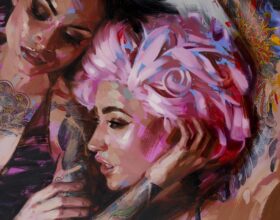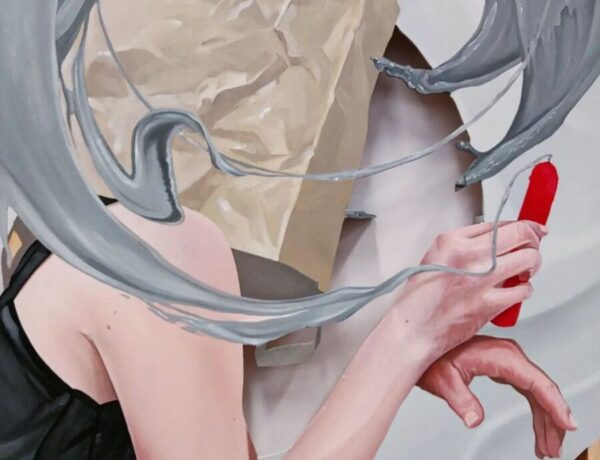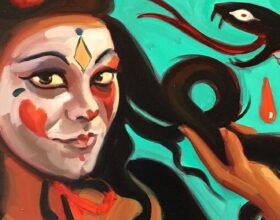I’m filled with a macabre kind of comfort when gazing upon the dark surrealist work of Jennifer Allnutt. Her body of work titled “Flowers of Evil” truly resonates with the morbid yet memorable expression “memento mori”. Fair skinned women lie with pained expressions enveloped in bouquets of vibrant flowers. These flowers soak up the life from these women blooming from the death and rot of humanity. Darkness cocoons each painting acting as both a warm blanket and a cold tomb for its subjects. Jennifer plays with seduction and profanity towing the lines between virtuosity and vulgarness, the decadent and disgusting exposing the frail line between life and death.
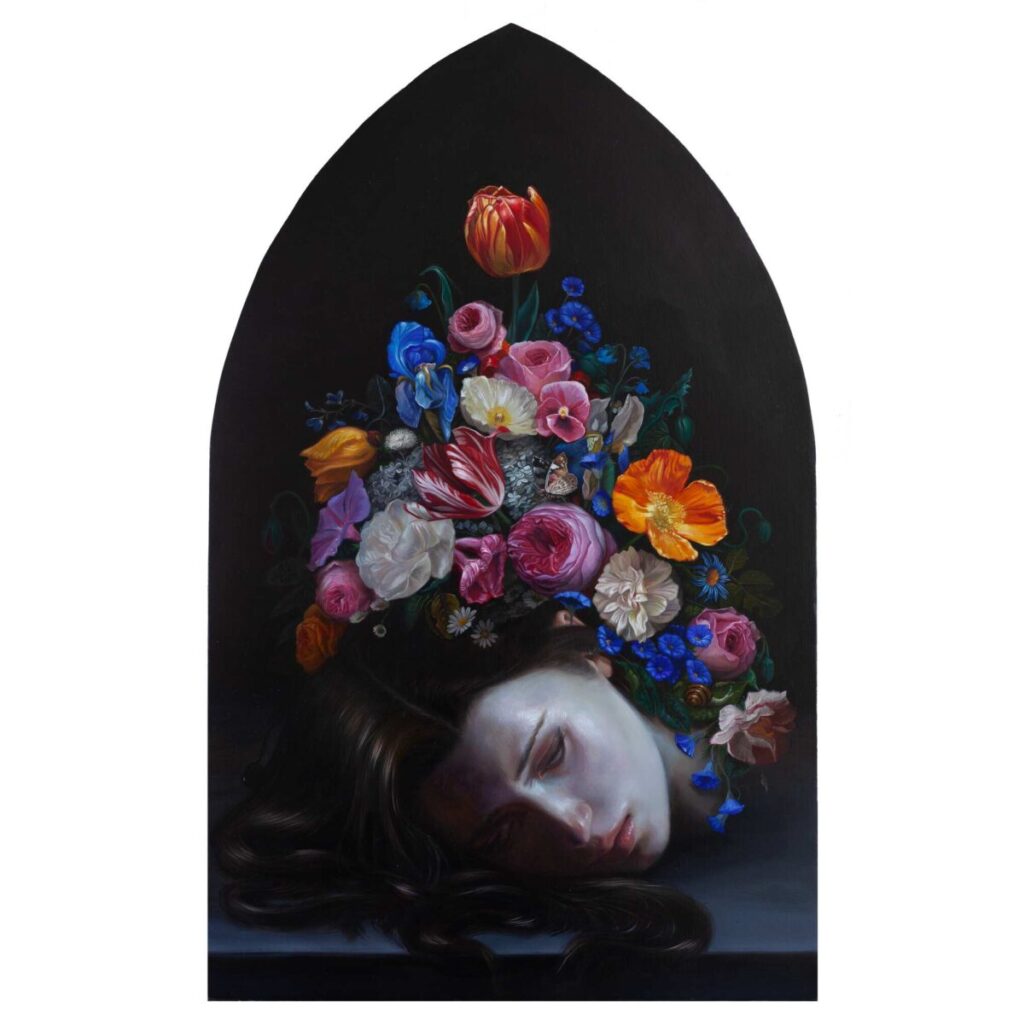

In Jennifer’s latest exhibition “Flowers of Evil” she invited viewers to explore her feminine interpretation of “The Flowers of Evil” by French poet, essayist and art critic Charles Pierre Baudelaire. Through a collection of 10 oil paintings, Jennifer explored her admiration for Baudelaire’s work as his poetry deeply resonates with Jennifer and her creative work.
Each piece in this collection, which was held at Beinart Gallery in Melbourne, Australia, plays with paradoxical themes of life and death, beauty and decay, salvation and damnation among various others showcasing how intrinsically linked these themes are and how one cannot exist without its opposite. Continue reading to find out more about Jennifer’s time working on “Flowers of Evil”.
Check out artworks from ‘Flowers of Evil’ currently on sale here.
In my paintings the female figures are a protagonist, rather than an object. There is a power in their softness.
Interview with Jennifer Allnutt
Upon reflection, how are you feeling now that the “Flowers of Evil” exhibition has concluded?
I’m really pleased with how it went! I remember looking at the works before I packed them,
all lined up, and I thought “would anyone buy these?” I did not have high hopes but I knew it
was a body of work that I was proud of and felt authentic to me. I think when you paint in general, a piece of your soul is put into the work. If you rush it or ‘half ass’ it then that will show in the work. It will be missing that small, crucial piece; a piece of your sustained, intense consciousness.


This exhibition is a love letter to Baudelaire’s poetry especially his seminal work “The Flowers of Evil”. What is it about his work that sparked the desire to create this exhibition?
I enjoy reading and learning and I’ve often felt my education was lack luster. While I was at university and art school I dedicated myself to reading literature classics in my spare time – the orange Penguin books and my grandpa’s collection. It’s exciting and frustrating to know how many greats I haven’t read.
So, I often look to the past for inspiration. I began this series by starting Paradise Lost by Milton and soon realised that perhaps this was too significant a task! I do intend to revisit that work but it is epic – I need to ruminate on it more. At the same time, I discovered Baudelaire and instantly felt a connection to his poetry. It is beautiful at times and crass at others, it seems to describe inner spiritual turmoil. I was entranced by the imagery the most.
While all the works borrow parts of imagery from the poems, ‘The Death of Artists’ is the only painting that is directly inspired by the poem of the same name and the line, “That death, a hovering new sun, will warm the flowers of their brains and make them grow.”
Alongside poetry, did you have any other influences whilst working on “Flowers of Evil”?
I’ve been reading a bit of Tolstoy -Anna Karenina recently, and I have a fascination with psychology. I listened to ‘Women who run with the Wolves’ by Clarissa Pinkola Estes while I made these works.
I also enjoy music and once I find something I like I tend to play it to death. During this body of work I listened to Nick Cave constantly and I’m sure he has read Baudelaire because there are so many synchronicities between their work. My other influence has been the band Ghost, I really enjoy their religious/satanic imagery and aesthetic. I’m influenced by the rock n’ roll version of Satan, because he seems to be a symbol of chaos but also of autonomy and I suppose Milton’s Lucifer is painted in a similar manner.
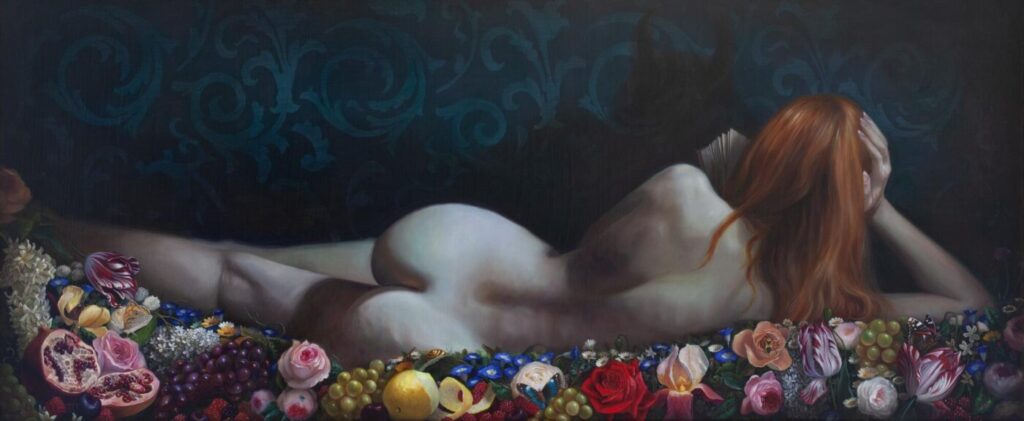
How long have your been working on this project and how did you approach tackling this body of work?
I’ve been working on it for two years but probably only painting for one year and then an intense painting period of six months to finish. I had other commitments during that time, and I like to ruminate on my ideas to see which ones stay and which ones fall away. That way it makes any easier choice for me. If I find myself continually sketching certain things then I know that maybe that idea is worth chasing. Or if I am writing the same line of poetry in my notebooks, I know there is something in that which is potent for me. I also enjoy sketching how the works might look in the gallery overall. I was drawn to the gothic arch because it reminded me of church windows and I liked the idea of turning the space into a pseudo dark church or temple with strange artifacts.

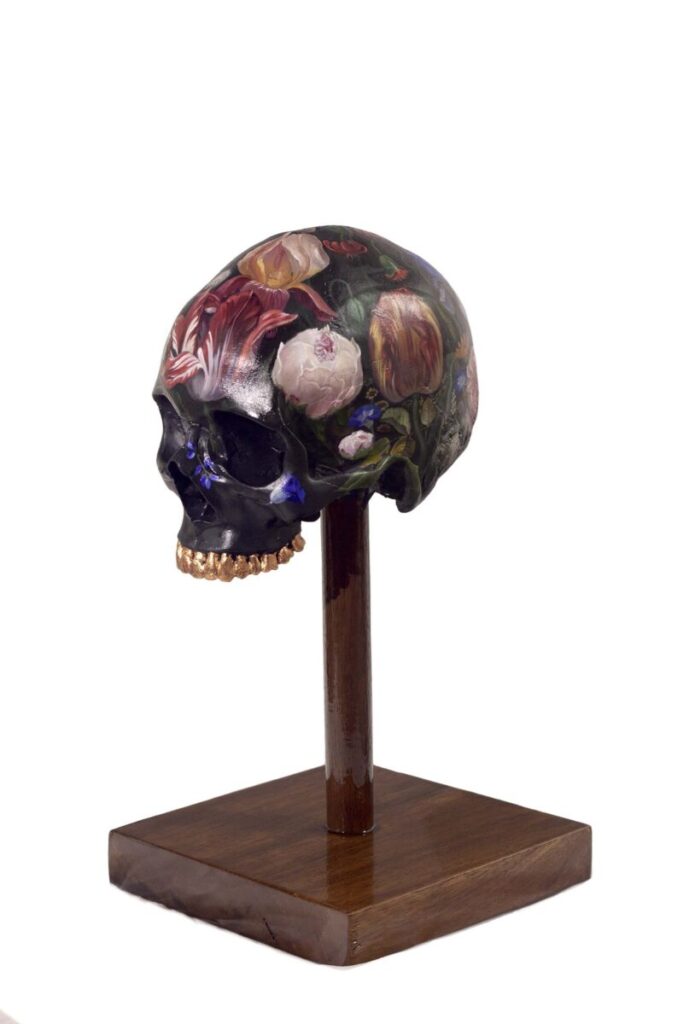
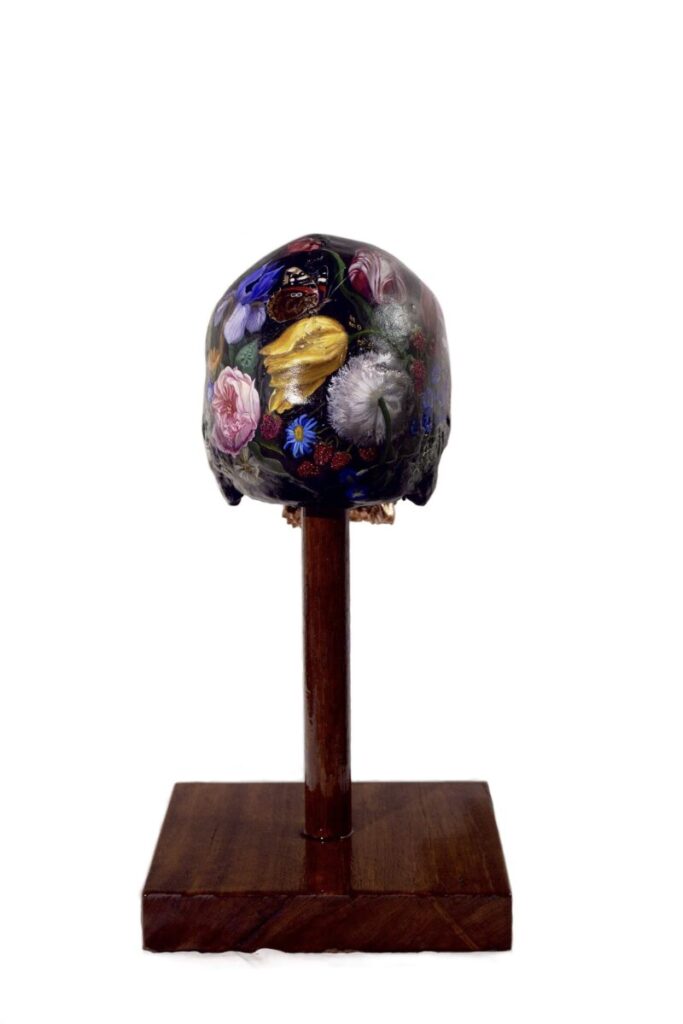
Your paintings have a dark sensuality to them, often feeling macabre yet quite sexy without being explicit. Would you say your work is targeted towards the female gaze?
The female gaze is important to me. If we take the male gaze to be an objectifying view: females are a mere sex object and portrayed as passive or helpless. So the female gaze I imagine means quite the opposite.
In my paintings, the female figure is a protagonist, rather than an object. There is a power in their softness. The way I view the devil is as a symbol of freedom and autonomy and I think my figures have the same feeling. I think of the story of Eve in the garden eating the apple – less as an act of temptation and perhaps more of an act of her free will and agency.
On a side note, I am not truly religious despite my Christian upbringing, I just find these stories fascinating in a psychological or symbolic way. For a long time I was ashamed of making particularly female artwork, I worried people would not take it seriously. As I’ve gotten older I’ve come to embrace or reclaim my femininity and be proud of it. I think that comes across in the artwork.
I think when you paint in general, a piece of your soul is put into the work. If you rush it or ‘half ass’ it then that will show in the work. It will be missing that small piece; a piece of your soul and sustained intense consciousness.
Speaking of the macabre, I understand the concept of death and the phrase “memento mori” has been with you since you were young. What is your relationship like with exploring themes of death and the macabre?
From a young age I have been very acutely aware of my own mortality; I was frightened. One of my earliest memories was in the cold light of morning lying in bed and watching the orchard out my window in that blue-green grey morning while I was coming to the realisation that I would die, having an existential crisis basically, and everyone I loved would die. I remember running into my parents bedroom balling my eyes out and not having the words to describe what I was feeling. I told them I had a bad dream about war.
Since then, I’ve found the normal way of living trivial. I would choose to live impoverished and be true to myself in every lifetime. Of course there are things I have to do to function in this society, but they are like a hobby and my art is my life’s work. Often, I find myself prone to nihilism but I find spiritual meaning in the painting process.
So, I suppose I paint these dark things to remind myself as much as anyone else, that we all must die. Kings, presidents, nobles and regular people we all have a timer, we are all in a large queue at deaths door. There is no dress rehearsal for life and no guarantees that you’ll make it to old age so I believe if I don’t do what I truly want right away, I may never get the chance. This life perspective is probably what drives the subject matter of my work and my interest in the macabre.
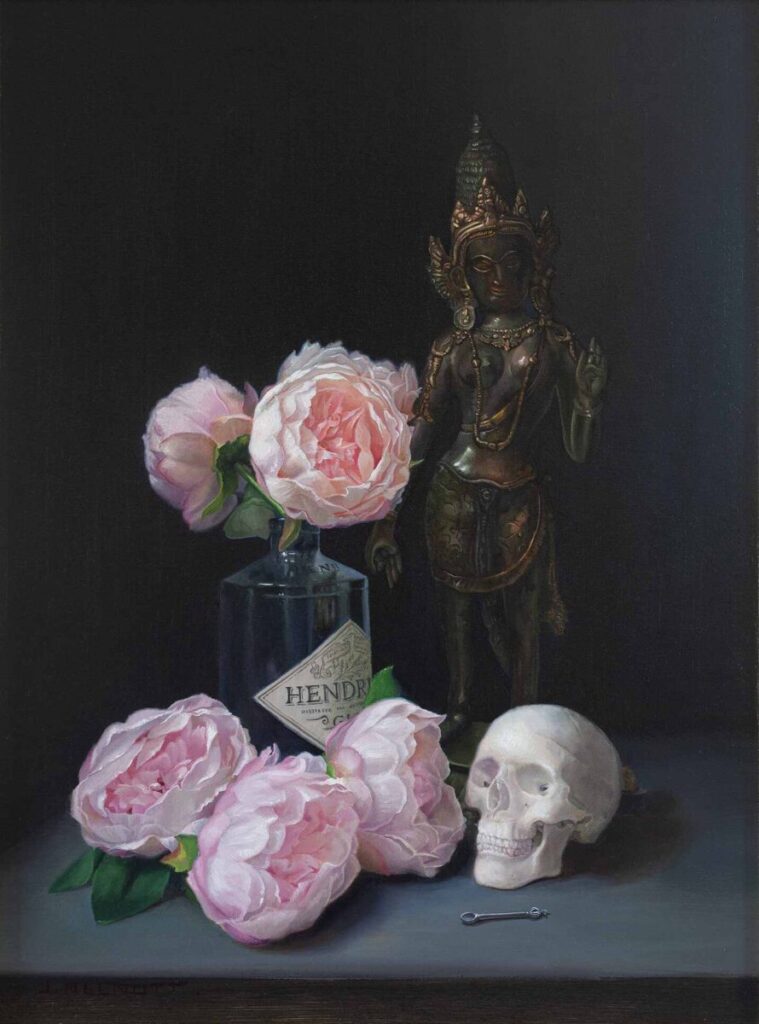

Are there any paintings from this exhibition that hold a particularly special place in your heart? If so, which ones and why?
The painting titled ‘Good Fortune’ that ruminates on symbols and superstition is actually a painting of my cat that lives with my parents. His name is Sir Thomas Shelby named after the Peaky Blinders character. His personality is pensive, he likes curling up like a cat loaf in a corner and listening to conversations secretly. He is also very loving and has such a loud purr for a tiny cat.
My mum constantly pestered me to make an entire collection of paintings of cats: her unsolicited advice for what I should paint always makes me laugh! So, I decided to concede and make her one painting but also because there are a number of cat poems in “The Flowers of Evil”, I suppose this is due to the fact that they are a potent symbol and Baudelaire’s gothic influence from Edgar Allan Poe (he translated to French several works by Poe).
The other painting that is significant is ‘Vices and Virtues’. It is a still life with objects that have nostalgic meaning and personal stories attached. I began this painting for my Grandpa, something I was chipping away at to eventually gift him in the old folks’ home. His room was so barren and sad, only a few mementoes were allowed. And this was a far cry from the maximalist house he had filled with treasures and stories.
The statue in the painting is the goddess Tara I believe, and it was one of his objects. I cleaned and dusted this thing I don’t know how many times over the years (during uni I cleaned every weekend) so when we were packing up his house this was one memento I decided to keep. Unfortunately, I had many roadblocks with this work and wasn’t able to finish it before he passed away. But I like to think he knows the love I put into it for him.
Not only do you paint on wooden panels but you also utilise more unusual canvases, such as replica skulls and sea shells. What draws you to painting on these unconventional canvases?
I enjoy the challenge of painting on unusual surfaces and the qualities these bring to the process. Because I work intuitively there are lots of happy accidents on the way that lead me down the rabbit hole to the finished work. Painting on objects adds an extra level or chance and spontaneity that I really enjoy.
A few years ago I started painting eyes on rocks as part of a residency and this is probably what sparked my fascination with unusual surfaces and also taught me the correct way to prepare the surface!
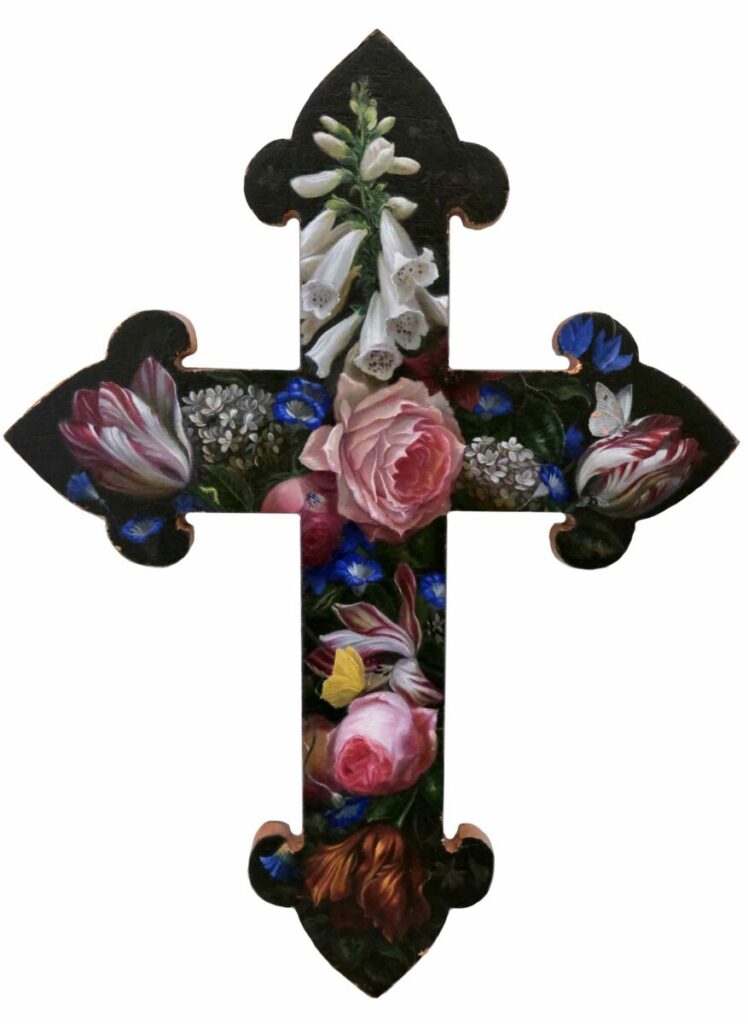
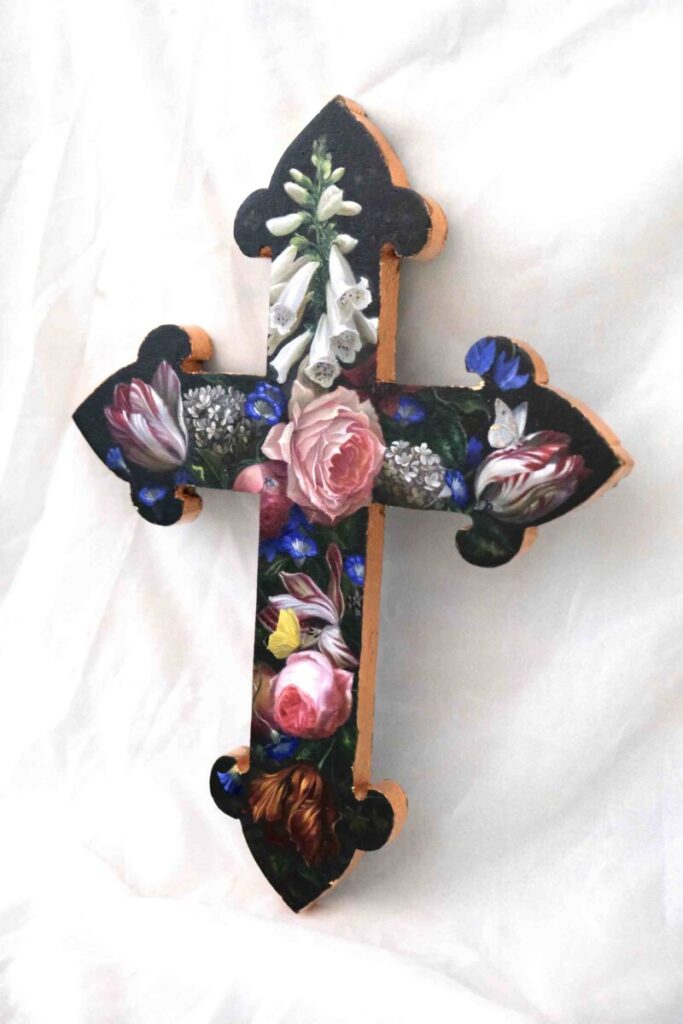
What has the response been like to ‘Flowers of Evil’? Has it been what you expected?
I have been overwhelmed by the kindness of strangers and people on the internet, not to mention the way my friends and family have supported and cheered me on. I try to take a moment to be present and feel the weight of my gratitude for this support.
What do you feel you have learned/gained from creating ‘Flowers of Evil’?
There is a quote by Baudelaire and I’m not sure where it is from precisely, but he says, aptly “the beautiful is always bizarre”. There is something exciting and thrilling about holding that tension between two contradictory forces. This is what “The Flowers of Evil” does so well and something I aim to emulate in my own work, in this series and going forward.
From this body of work I feel I have gained some clarity about my artistic practice and as with every painting I feel I am getting closer to the qualities of the artists I admire and contributing a small part in the long tradition of painting.
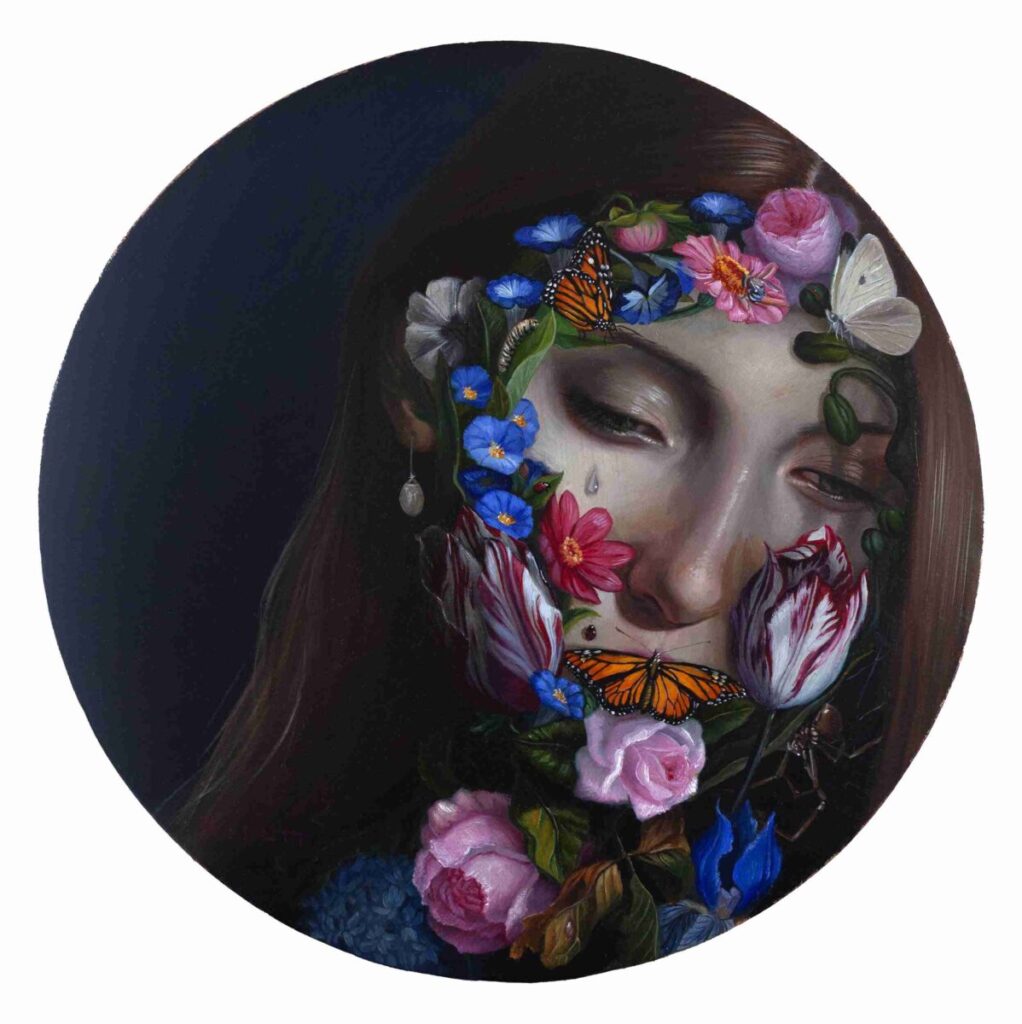
What’s next for you? And exciting projects on the horizon or concepts you’d like to develop?
Currently I’m working towards two solo exhibitions, one at Lethbridge Gallery in Queensland in 2025 and another for Beinart Gallery in 2026 in Melbourne. I’m excited and honoured to be working with two amazing galleries in Australia! As well as this I try to fit in as many group exhibitions as I can!
I imagine this series and the poetry is going to impact my work for many years to come and I’ve only just scratched the surface of my ideas. Excited to see where I go to next!
For inquires on purchasing an artwork from this exhibition please contact Beinart Gallery on their website.


